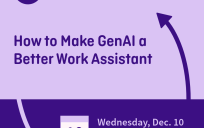This blog post is an excerpt from GovLoop’s recent industry perspective, “Making the Most of Knowledge Management to Improve Government Services.”
Citizens now expect the same types of services from government agencies as they do from their banks, favorite stores and other businesses. Agencies must treat their constituents as longterm customers by keeping up with trends in communication, technology and mobile connectivity.
While agencies have for years looked at different ways to increase and modernize customer service, the cost frequently outweighed the benefits, and many times distracted from the main mission.
For agency leaders, the main challenge is to be able to improve external facing service and internal processes at the same time. Making the most of knowledge management strategies and tools is essential to this effort. Not only does applying knowledge management help to improve interactions with citizens, it also empowers employees to be more productive and consistent in service delivery.
When applying the term to customer service, knowledge management is an integrated approach to identifying, capturing, evaluating, retrieving and sharing an enterprise’s information assets (i.e., documents, databases and procedures) surrounding customer data. Agencies can still robustly safeguard customer data even while using it with knowledge management.
But how can government effectively apply knowledge management techniques to improve citizen engagement as well as employee productivity at the same time?
The answer lies in agencies making the most of knowledge management, Kevin Briggs, Director of Microsoft Dynamics 365 in the Federal Public Sector Unit, and Tom Yang, Solutions Architect for Dynamics 365, said in an interview with GovLoop. With the right strategies and tools, government can improve customer service delivery while making employees more efficient. Knowledge management is also a logical place to start for most agencies, providing a strong initial foundational step in a digital transformation journey.
“Government-citizen interactions are broad in scope,” Briggs said. “You could have someone filling out a Census survey or applying for a driver’s license. The challenge is your customer engagement strategy requires proven and consistent services delivered across many channels. It encompasses the right mix of people, processes and technology.”
Knowledge Management For Customer Service
By applying strategies and best practices like omni-channel engagement, self-service, single user interfaces, knowledge bases, digital intelligence and mobile solutions, agencies can turn knowledge management into a comprehensive customer service strategy.
“With knowledge management, you need the right enterprise and customer-centric approach,” Yang said. “It needs to be one set of resources that can span multiple departments to address the silo effect, and it has to help employees share information and crowdsource.”
Effective knowledge management can make an agency’s data and information available to only relevant internal employees using a content management system. Rather than employees having to worry about paperwork with PII scattered across different offices, knowledge management helps centralize citizen information and files into one easily accessible platform and portal. Agencies can choose to personalize experiences using this data if allowed, such as to provide a portal where citizens can log in and see their services, benefits or resources.
From a security perspective, there can be separate layers used where generic resources never touch citizen information. “Knowledge management technologies allow you to collect and store customer data,” Yang said. “Authentication and the storage service provides security. To additionally lower the risk, there may be services you provide that don’t touch PII. For example, you could build a chatbot on your website to answer frequently asked public questions based on data that doesn’t necessarily tie back to the citizen. This allows you to understand your constituent needs better and customize accordingly without ever touching or jeopardizing their PII.”
For knowledge management to improve citizen services and employee productivity, a comprehensive strategy must address cultural agency silos, self-services for citizens, multiple channels for engagement and personalization.
To take advantage of all the customer service benefits that knowledge management can offer, agencies should provide:
–Omni-channel engagement: Give citizens what they need, on any channel, whether it’s through a call center, on an agency’s website, via walk-in or on social media. Use a unified platform that makes information available across a variety of types of engagement channels. That way, agencies can also offer the consistency and personalization customers expect.
–Self-Service: Make it easy for citizens to find answers on their own. Self-service portals provide a searchable knowledge base and an online community space, as well as the ability to immediately find answers. Technologies like bots can help to make the interaction more natural, by providing more conversational interactions than just a list of FAQ’s.
–Single user interface with mobility and security: Equip agency employees to handle service interactions from their desktop or mobile device, while adhering to needed security and compliance requirements. This single interface should provide a single view into all citizen information and enable employees to provide personalized service quickly and securely.
-Searchable knowledge base: Give employees and customers the answers they need on the spot. The knowledge base provides consistent answers across all engagement channels. Periodic reviews from customers help keep employee responses current and relevant. Additionally, agencies can get indepth analytics to measure the impact and quality of responses.
-Built-in digital intelligence: Using data analytics, be more predictive and proactive in customer service. Digital intelligence should incorporate interactive dashboards and data visualizations to help agencies pull insights from customer service metrics, making it easier to identify trends and anticipate opportunities.
These capabilities will not only enable agencies to break down knowledge barriers and silos; they will also empower employees to keep track of their constituents’ needs, FAQs and most frequently used services.
With the increased visibility and emphasis on customer service, especially by government agencies, using an effective knowledge management strategy and tool can help engage and serve citizens through self-service channels and at the same time empower employees to be more productive and consistent. By empowering workers with more efficient and collaborative tools, knowledge management can increase citizen satisfaction and solidify long-term, trusted relationships. The right tools provide greater transparency, allow for improved accuracy, personalization and faster resolution time. Lastly, leaders can equip their agencies to allow for more efficient and effective communication across a wide variety of channels. With the insights from informed data, government leaders and employees can also extract deeper understandings to make more informed decisions in order to better serve their communities.





Leave a Reply
You must be logged in to post a comment.